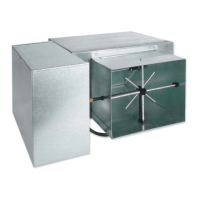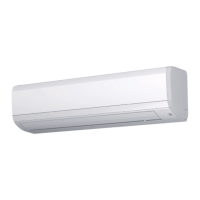JOHNSON CONTROLS
7
FORM 130.13-NOM1 (114)
Allow a minimum of 1½-duct diameters of straight
duct prior to equipment inlet and equipment discharge.
The diameter of the inlet duct for round valves must
be equal to the listed size of the equipment. The round
air valve inlet collar of the equipment is 1/8" smaller
then listed size in order to allow the round ductwork to
slip over the air valve inlet collar. DO NOT INSERT
DUCTWORK INTO AIR VALVE INLET COLLAR.
When making ductwork connection to air valve inlet
collar and insulating air valve inlet, take caution not to
damage or remove the ow sensor connections, which
are vital to unit control. Provide insulation around entire
inlet collar (all the way to the equipment casing).
Permissible discharge duct connections are straight
anged, slip and drive or drive and screw.
If equipment is to be installed in a location with high
humidity, external insulation around the heating coil
should be installed.
Sound Critical Applications
Flexible duct connectors are not recommended on
equipment discharge. The sagging membrane of these
ttings can cause turbulence and higher air velocities
that generate noise. Also, lightweight membrane
material allows noise to breakout, which can increase
sound levels in the space below.
Coil Connections
Hot water and steam coils are male sweat connections.
Use appropriate brazing alloy for system temperature
and pressure. Refer to unit construction submittal
drawing for specic connection size. MAXIMUM
HYDRONIC SYSTEM OPERATING PRESSURE
MUST NOT EXCEED 300 PSIG. MAXIMUM
STEAM SYSTEM PRESSURE MUST NOT EXCEED
15 PSIG.
Electrical
All eld wiring must comply with NEC and all local
codes. Electrical and/or control wiring diagrams are
located on the control enclosure box. All electric heaters
are staged per specications.
The installing electrician should rotate the incoming
electric service by phase to help balance the building
electrical load.
Minimum circuit ampacity (MCA) designates the
maximum operating load of the equipment for sizing
wire feeders. Fuse size of the internal fuse if supplied.
Maximum Overcurrent Protection (MOP) designates
the largest breaker or fuse in the electrical service panel
that can be used to protect the equipment.
Use Copper conductors only.
OPERATION
Start-Up
Thorough safety precautions should always be taken
when performing startup and service. Only qualied
individuals should perform these tasks.
Check that all electrical work is nished and properly
terminated. Check that all electrical connections are
tight and that the proper voltage is connected.
3 Phase Balancing
AC power imbalance must not exceed 2%. Be sure that
the following guides are met:
1. AC power is within 10% of rated voltage at rated
frequency. (See equipment nameplate for rat-
ings).
2. AC power is within 5% of rated frequency at rated
voltage.
3. A combined variation in the voltage and frequency
of 10% (sum of absolute values) of rated values,
provided the frequency variation does not exceed
5% of rated frequency.
Equipment with electric heat requires
a minimum of 0.1" w.g. downstream
static pressure.
Prior to start-up, the project control sequence/wiring
diagram should be obtained and thoroughly understood.
If factory supplied analog or DDC controls are utilized,
refer to the applicable Operation Manual for start-up
and balancing information.

